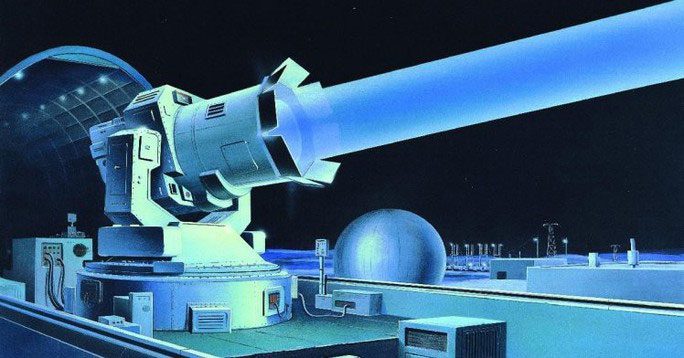Recently, Russian President Vladimir Putin revealed that the Russian defense industry is developing advanced weapons based on “new physical principles” to ensure national security. So, what are these mysterious weapons?
Noteworthy Messages from Russia Regarding Mysterious Weapons
During his speech at the Eastern Economic Forum on September 12, Putin stated: “If we look at the area of security, weapons based on new physical principles will ensure the security of any nation… We understand this very well and are striving to develop it.”
The head of the Russian state did not go into detail, leading the media and military observers to exert considerable effort in seeking information about what lies behind his statement.

An image of a Soviet laser weapon envisioned by the country’s defense intelligence in the 1980s. (Source: Cooper).
The official online encyclopedia of the Russian Ministry of Defense defines “weapons based on new physical principles” as “new types of weapons whose effectiveness is based on processes and phenomena never before used for military purposes.”
At the beginning of the 21st century, such weapons were believed to include the following:
Directed Energy Weapons (such as laser-based weapons, particle accelerators, microwaves, and acoustic waves, designed to destroy or disable personnel, equipment, and fortified infrastructure of the opponent). According to the Russian Ministry of Defense: “All types of directed energy weapons are practically non-inertial, except for acoustic wave weapons, and are instantaneous… Significant successes have been achieved in this direction with the improvement of laser weapons.”
Electromagnetic Weapons (weapons based on ultra-high frequencies and lasers), characterized by their destructive capabilities due to the use of a “powerful pulsed electromagnetic radiation field, or incoherent optical radiation.”
Non-lethal Weapons, used to incapacitate personnel and equipment without causing irreparable losses…
Geophysical Weapons (seismic, climate, ozone, environmental), which the Russian Ministry of Defense generally defines as the group of “active means to influence the environment to use the forces of nature for military purposes.”
These weapons are designed to impact solid, liquid, and gaseous materials of the planet and atmosphere, capable of using large explosions to cause earthquakes, volcanic eruptions, and other disasters, as well as altering weather and climate in certain regions of the Earth, leading to droughts, floods, storms, etc.
Ozone Weapons are designed to create holes in the ozone layer, causing widespread damage from ultraviolet radiation from space to large geographical areas.
Finally, Environmental Weapons are defined as weapons targeting forests, crops, water sources, air, and land, potentially through chemical or biological agents.
Radiological Weapons include types of weapons with destructive effects “based on the use of radioactive materials capable of contaminating personnel through ionizing radiation without the need for a nuclear explosion.” Here, the emitting material is derived from radioactive fuel waste or by exposing chemical elements to a neutron stream to create radioactive isotopes.
These weapons can be placed in artillery shells, dirty bombs, missile warheads, and other conventional munitions. The goal is to contaminate the environment of a particular area for decades, even hundreds of years.
Gene Weapons are defined as “a form of weapon that can damage the genetic machinery of humans,” including methods using viruses with mutated genes, as well as “mutations created from natural sources through chemical synthesis or biotechnology to cause damage or alterations to DNA.” According to assessments by the Russian military, this type of weapon is particularly dangerous due to its “unpredictable consequences” when used.
Revealing Russia’s Secrets
So what is Russia researching in terms of weapons based on new physical principles?
The Russian military is particularly secretive about the types of weapons based on new physical principles they are developing.
However, there are indications of the priorities and concerns of the Russian military in this field.
Firstly, as a signatory to the Biological Weapons Convention, Russia has imposed a ban on the development of gene weapons.
Secondly, due to possessing the world’s nuclear arsenal, Moscow has also ruled out the creation of radiological weapons (also known as dirty bombs), which they believe could easily fall into the hands of terrorist groups.
Veteran military observer Viktor Murakhovsky told Sputnik that the weapons President Putin referred to are likely to be laser weapons and other types based on high-energy physics.
According to Murakhovsky, Russia has made significant progress in both hypersonic missiles and laser weapons due to fundamental research dating back to the 20th century.
Murakhovsky stated: “We have been developing laser weapons for a very long time, since the 1970s.”
In 2016, Murakhovsky recalled, then-Prime Minister Dmitry Medvedev witnessed a demonstration of a laser weapon against UAVs at the Laser Physics Institute. Subsequently, the Russian state pushed for the rapid application of this technology in the military field.
So what drives Russia to develop these fundamental new types of weapons?
On this matter, former U.S. Air Force Colonel Karen Kwiatkowski told Sputnik that the Western doctrine of “containment” is directly responsible.
According to Karen Kwiatkowski, the dialectical process here is that the rest of the world, including Russia, has been forced to devise military and economic strategies to respond to NATO’s doctrine.


















































